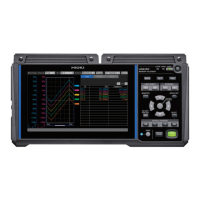11
Knowledge and Information
11.1 Measuring Temperature
This section provides precautionary information related to thermocouples, which are widely used to
measure temperature.
Choosing the right thermocouple
The following thermocouples can be used with the instrument:
Thermocouple
Temperature range
for which tolerance is
dened by JIS C 1602 (°C)
Characteristics
K −40 to 1200 Has a linear relationship between temperature and thermal
electromotive force; the most widely used in industrial applications.
J −40 to 750 Has the second-highest electromotive force per degree of
temperature, after E thermocouples.
E −40 to 900 Has the highest thermal electromotive force per degree of
temperature, which allows eects of noise to be reduced.
T −40 to 350 Has high electromotive force in the low-temperature domain
(−40°C to 350°C). Is used to make precise measurements in the
low-temperature domain.
N −40 to 1200 Exhibits stable thermal electromotive force from low to high
temperatures. Is used to make measurements in the high-
temperature domain at low cost.
R 0 to 1600 Is used to make measurements in the high-temperature domain.
Oers excellent oxidation and chemical resistance, but at high
cost.
S
B 600 to 1700 Is used to make measurements in higher temperature domains
than R and S thermocouples. Cannot make measurements in the
low- and medium-temperature domain due to its extremely low
electromotive force.
C 426 to 2315 Can make measurements at the highest temperatures.
K and E thermocouples exhibit a physical phenomenon known as short range ordering in which
thermal electromotive force increases gradually from 250°C to 600°C, producing a large error in a
comparatively short period of time (1 h or less). This unavoidable phenomenon is caused by the
device’s physical characteristics. Once a thermocouple’s thermal electromotive force has increased,
it will not return to its normal value, even if the temperature falls. In order to return to the original
thermal electromotive force curve, the temperature must rise to at least 650°C.
Choose the appropriate thermocouple after checking with the manufacturer.
Error caused by thermocouple heat dissipation
When a thermocouple is applied to a surface, heat dissipates (is conducted) from the measurement
target via the thermocouple. If heat under measurement is excessively conducted through a
thermocouple, the measured value will not reect the actual temperature.
Of K and T thermocouples, the latter is characterized by higher heat dissipation due to its superior
thermal conductivity.
The larger the thermocouple’s diameter, the greater its heat dissipation.
When measuring the temperature of small components, it is recommended to use a small-diameter
K thermocouple.
Ensuring the thermocouple is securely axed to the measurement target
To measure temperature with a high degree of precision, ensure that the tip of the thermocouple is
securely axed to the measurement target.
If the thermocouple junction is insuciently placed into contact with a measurement target, the
heat cannot conduct to the thermocouple, with the result that the measured value will not reect the
actual temperature.
When measuring a large measurement target, you can reduce the amount of heat dissipated from
the thermocouple by ensuring that more than just the tip of the thermocouple is in contact with the
measurement target.
11 Knowledge and Information
Knowledge and Information
www.GlobalTestSupply.com
Find Quality Products Online at: sales@GlobalTestSupply.com

